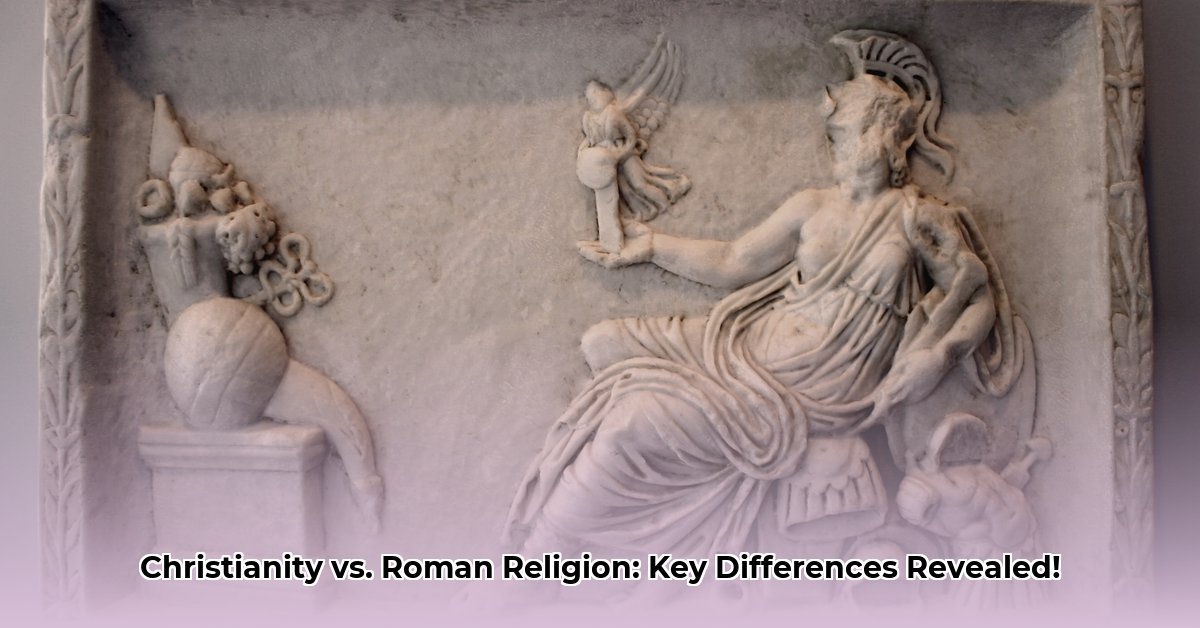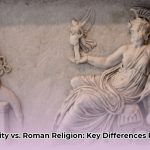Imagine two vastly different worldviews converging, eventually leading to a profound societal transformation that reshaped the ancient world. This scenario unfolded dramatically as Christianity emerged within the established framework of the Roman Empire. Learn more about the magnificenttemples of ancient Rome. This article, “The Great Divide: Unveiling the Profound Differences Between Christianity and Ancient Roman Religion,” delves into the fundamental distinctions between these two powerful belief systems. We will explore how a shift from polytheism (the belief in many gods) to monotheism (the belief in one God), along with revolutionary perspectives on the afterlife, moral conduct, and societal roles, ultimately led to Christianity’s rise and the enduring transformation of Roman civilization. While distinct, these faiths also influenced each other in surprising and intricate ways.
Core Theological Divide: One God vs. Many Gods
A cornerstone difference between Christianity and the ancient Roman religion lies in their theological foundations. This fundamental divergence shaped every other aspect of their respective cultures and practices.
The Roman Pantheon: A Tapestry of Deities
Ancient Roman religion was profoundly polytheistic, characterized by a vast and intricate pantheon of gods and goddesses. Each deity held sway over specific aspects of human life, natural phenomena, and the state. For instance, Jupiter Optimus Maximus was revered as the king of gods and the protector of Rome, Mars as the formidable god of war and agriculture, and Venus as the embodiment of love, beauty, and fertility. The Romans believed these deities actively influenced human affairs, and maintaining their favor—known as pax deorum (peace of the gods)—was paramount. This was achieved through meticulous adherence to religious rituals, public ceremonies, festivals, and offerings, all designed to ensure the prosperity, stability, and security of the Roman state. Religious observance was deeply intertwined with civic duty and national identity; a loyal Roman was expected to honor the state gods. Individual devotion was often secondary to collective ritual.
Christian Monotheism: A Singular Divine Being
Conversely, Christianity introduced a revolutionary and uncompromising concept: monotheism. It proclaimed the existence of a single, all-powerful, omnipresent God who created the universe and remains the exclusive, singular object of worship. This unified divine being, the God of Abraham, Isaac, and Jacob, replaced the intricate web of Roman deities. Worship was directed solely to this one God, rejecting all other gods as false idols. This exclusive devotion was a direct challenge to the polytheistic Roman system and was a primary source of conflict, as Christians refused to participate in state cults or worship the emperor. The very first commandment in Christian scripture, “You shall have no other gods before me,” directly encapsulated this foundational difference.
Afterlife and Purpose: Earthly Prosperity vs. Eternal Salvation
The primary focus and ultimate goals of each belief system also varied significantly, shaping individual and communal aspirations.
Roman Focus: Prosperity in This Life
Roman religion primarily centered around securing blessings and prosperity in the present life for the Roman state and its citizens. Its rituals and ceremonies were aimed at appeasing the gods to ensure military victories, abundant harvests, public health, and overall well-being. The emphasis was on maintaining pax deorum to guarantee the continued flourishing of the community and empire. There was no uniform or clearly defined concept of an afterlife dependent on individual moral conduct during one’s lifetime. While ideas about the underworld (like Hades or the Elysian Fields) existed, they were often vague, fragmented, and did not hold the central, motivating force that the Christian concept of salvation did. The fate of the individual soul in the afterlife was less of a concern than the collective fate and prosperity of Rome.
Christian Focus: Personal and Eternal Salvation
Christianity, however, profoundly reoriented this perspective towards eternal life and individual salvation. It promised personal redemption and everlasting life in heaven through faith in Jesus Christ, repentance for sins, and adherence to his teachings. This message underscored the immense importance of individual belief, personal conversion, and moral behavior as the pathways to divine grace and eternal redemption. The focus shifted from appeasing deities for earthly gains to cultivating a personal relationship with God, living a life of righteousness, and securing a place in the afterlife. The death and resurrection of Jesus Christ were central to this doctrine, offering hope for overcoming death and achieving spiritual rebirth. This radical shift offered solace and purpose that resonated deeply with individuals across all social strata.
Moral Compass: Virtus as Civic Duty vs. Agape as Divine Love
The ethical frameworks of these two religions diverged substantially, influencing how individuals were expected to live and interact with society.
Roman Virtus: Excellence in Civic and Military Life
Roman morality was deeply rooted in the concept of virtus, which encompassed a range of virtues essential for a good Roman citizen and the maintenance of the state. Virtus primarily meant courage, honor, duty (pietas – devotion to gods, family, and state), self-control, and unwavering loyalty to Rome. A Roman citizen was expected to prioritize the needs of the Republic or Empire above all else, engaging actively in military service, participating in public life, and upholding traditional ancestral values (mos maiorum). The ideal Roman was a responsible, disciplined individual driven by a sense of duty to his family and, most importantly, to the state. Glory and reputation were often tied to public service and military achievement.
Christian Agape: Unconditional, Selfless Love
Christianity introduced a novel and revolutionary ethical framework rooted in agape (unconditional, selfless love), compassion, and forgiveness. The teachings of Jesus, particularly as articulated in the Sermon on the Mount, highlighted the profound importance of loving God with all one’s heart and loving one’s neighbor as oneself. This extended to loving one’s enemies, turning the other cheek, and caring for the poor, marginalized, and vulnerable. This paradigm emphasized inner transformation, humility, and a radical commitment to peace and justice that often transcended social status or national allegiance. It introduced concepts like universal brotherhood and the inherent dignity of all human beings, regardless of their social standing, wealth, or power. This focus on an internal moral compass, driven by divine love, set it apart from the external, civic-oriented morality of Rome.
Societal Transformations: Justice, Slavery, and Women’s Roles
The contrasting moral and theological foundations led to significant divergences in societal norms, particularly concerning justice, the institution of slavery, and the roles ascribed to women.
Justice: State Protection vs. Grace and Redemption
The Roman legal system, renowned for its sophistication, aimed for fairness and order, often imposing harsh punishments as a means to deter crime and maintain social stability. Justice was largely retributive, focusing on proportionate responses to offenses and protecting the state from those who would harm it. Public executions were common, serving as stark warnings.
Christianity, conversely, viewed justice through the lens of mercy, forgiveness, and the potential for redemption. While God is seen as just, His justice is often tempered by grace, offering individuals a chance to repent and be reconciled. This perspective gradually influenced attitudes towards punishment, emphasizing rehabilitation and the inherent dignity of the offender, though full societal adoption of these principles took centuries.
Slavery: Property vs. Human Dignity
The practice of slavery highlights one of the most stark and deeply rooted differences. In Rome, slavery was a normal, pervasive, and widely accepted custom; slaves were considered property (instrumenta vocalia – “speaking tools”), possessed no legal rights, and formed an indispensable part of the Roman economy, performing labor in mines, farms, and households. While laws existed to prevent extreme mistreatment, owners had absolute control.
Christianity, however, fundamentally challenged this institution by asserting that all humans are equal before God, irrespective of their social or legal status. While the New Testament often urged slaves to obey their masters, it simultaneously taught masters to treat slaves justly and kindly, implicitly undermining the very foundation of slavery. Many early Christians freed their slaves, and the Church played a significant, albeit long and complex, role in advocating for the dignity of all individuals and contributing to the eventual decline and abolition of slavery in Europe.
Women’s Roles: Domestic Sphere vs. Spiritual Equality
In Roman society, women were largely confined to domestic roles and were not allowed to participate in public life, politics, or the military. Their legal status was often dependent on their husbands or fathers, and their primary role was that of homemaker and mother. While some wealthy women could be educated and exert influence within their households, their public sphere was extremely limited.
Christianity, while still operating within patriarchal societal norms of the time, offered women a significantly different spiritual status. The teachings of Jesus included women among his followers, and early Christian communities often saw women playing active roles in religious activities, including prophecy, teaching, and leadership within the church, as evidenced in the Pauline epistles. From a spiritual perspective, Galatians 3:28 declared, “There is neither Jew nor Gentile, neither slave nor free, nor is there male and female, for you are all one in Christ Jesus.” This principle, emphasizing spiritual equality before God, provided a foundation for increased recognition of women’s inherent worth, even if full societal equality was far from realized.
Interwoven Histories: Interaction, Adaptation, and Influence
The relationship between Christianity and Roman religion was not merely one of opposition but also a dynamic and intricate interplay involving adaptation, assimilation, and mutual influence.
Christian Adaptation of Roman Structures and Customs
As Christianity expanded throughout the Roman Empire, it inevitably interacted with and, in some ways, adapted aspects of Roman culture. Early Christians often utilized the basilica (Roman public administrative building) as a blueprint for the design of their communal worship spaces, influencing the architecture of early churches. Some scholars also argue that certain Christian festival dates, such as Christmas on December 25th, were strategically chosen to coincide with existing Roman pagan celebrations (like the festival of Sol Invictus – the Unconquered Sun) to ease the transition for new converts and embed Christian holidays within the existing cultural calendar. Even visual symbols, like the halo in Christian art, might have been reinterpreted from pagan divine imagery, aiding communication within a society already familiar with such visual archetypes. These adaptations demonstrate a practical and often strategic approach to religious dissemination, allowing Christianity to integrate more smoothly into the prevailing cultural context.
Roman Influence on Christian Organization and Language
The Roman Empire’s highly organized administrative and legal structures also left an indelible mark on Christianity. The early Church adopted aspects of Roman organizational hierarchy, developing a structured system of bishops, deacons, and presbyters that mirrored the provincial administration of the empire. Latin, the language of the Roman Empire, became the lingua franca of the Western Church, deeply influencing Christian theology, liturgy, and legal traditions for centuries. Many theological terms in Western Christianity derive directly from Latin concepts.
The “Borrowing” Debate: Syncretism vs. Distinct Identity
The extent of Christian “borrowing” from pagan traditions remains a subject of active scholarly debate. Some academics emphasize the syncretic nature of religious interaction, suggesting that pagan beliefs genuinely shaped Christian practices and worldviews in a more fundamental way. Others argue that while superficial adaptations occurred for cultural integration, the core theological identity and doctrines of Christianity remained distinct, rooted firmly in Judaism and the teachings of Jesus. They maintain that adaptations were primarily strategic, designed to facilitate communication and acceptance without compromising essential beliefs. Regardless of the interpretation, the cultural exchange was complex and multifaceted, resulting in intertwined religious identities that evolved over time.
The Rise of Christianity: From Persecution to Empire’s Faith
The journey of Christianity within the Roman Empire was fraught with challenges, yet it ultimately triumphed, profoundly altering the trajectory of Western civilization.
Early Persecution: A Threat to Pax Deorum
Initially, the Roman state viewed Christianity with suspicion and often outright hostility. Christians’ unwavering refusal to worship Roman gods, participate in state cults, or offer incense to the deified emperor was perceived as disloyalty, defiance, and a direct threat to the pax deorum. This non-conformity was seen as undermining the very fabric of Roman society and inviting divine displeasure upon the empire. This led to periods of severe persecution, during which Christians faced imprisonment, torture, public executions, and even martyrdom for their faith. Despite these intense trials, Christianity continued to spread, attracting followers from all social classes, including slaves, women, and even members of the Roman elite.
Constantine’s Conversion and the Edict of Milan
A pivotal and transformative moment arrived in the early fourth century CE with the conversion of Emperor Constantine. Following his vision before the Battle of Milvian Bridge in 312 CE, Constantine embraced Christianity (though he was only baptized on his deathbed). In 313 CE, he issued the Edict of Milan, a landmark decree that granted religious tolerance throughout the entire Roman Empire, effectively ending the systematic persecution of Christians. This edict not only legalized Christianity but also restored confiscated Church property and provided imperial favor.
Christianity Becomes the State Religion
Constantine’s conversion was merely the beginning. By the late fourth century CE, Christianity solidified its position. Emperor Theodosius I, through the Edict of Thessalonica in 380 CE, declared Nicene Christianity the official state religion of the Roman Empire. This transformation profoundly impacted every facet of Roman society and culture, leading to the gradual decline and eventual suppression of traditional Roman polytheism and the emergence of a new Christian civilization. Temples were converted into churches, pagan rituals were gradually outlawed or absorbed, and Christian ethics began to permeate legal and social structures.
| Feature | Ancient Roman Religion | Christianity |
|---|---|---|
| Theology | Polytheistic (many gods and goddesses) | Monotheistic (one God) |
| Primary Focus | State prosperity, cosmic harmony (pax deorum), civic duty | Personal salvation, eternal life, divine love |
| Moral Code | Virtus (courage, honor, loyalty to state, discipline) | Agape (unconditional love, compassion, forgiveness, humility) |
| Afterlife | Vague, fragmented concepts; less central to daily life | Clear concept of eternal life (heaven/hell), central to doctrine |
| Worship Place | Temples, public shrines, homes | Churches, cathedrals, house churches |
| Clergy | Priests, augurs, Vestal Virgins (often state officials) | Bishops, priests, deacons (distinct spiritual hierarchy) |
| Sacred Texts | Oral traditions, myths, legal treatises, Sibylline Books | The Bible (Old and New Testaments) |
| Social View | Hierarchical, accepted slavery, limited women’s public roles | Emphasized spiritual equality, challenged slavery’s morality |
| Relationship to State | Integrated, state-sponsored religion | Initially persecuted, later became state religion |
Enduring Legacies: Shaping Western Civilization
The collision and confluence of Roman and Christian values have shaped the bedrock of Western civilization. Our modern legal systems owe a profound debt to Roman jurisprudence, with its emphasis on codified law, justice, and governance. The concepts of natural law, civic duty, and a structured state can trace their origins to Roman thought.
Simultaneously, our ethical frameworks are deeply influenced by Christian teachings. The Christian emphasis on compassion, human rights, social welfare, charity for the poor, the inherent dignity of every human being, and the principles of forgiveness and mercy have permeated Western moral and philosophical thought. The establishment of hospitals, orphanages, and educational institutions, often spearheaded by the Church, reflects this enduring impact.
Ultimately, the transformation from a polytheistic Roman Empire to a predominantly Christian civilization marked one of the most significant shifts in human history. Understanding these contrasting and converging ideals, their conflicts, and their adaptations provides invaluable insights into the complex historical, ethical, and cultural forces that have molded the world we inhabit today. The legacy of both ancient Rome and early Christianity continues to shape our laws, our values, and our understanding of self and society, proving that even the widest divides can lead to profound and lasting transformation.










